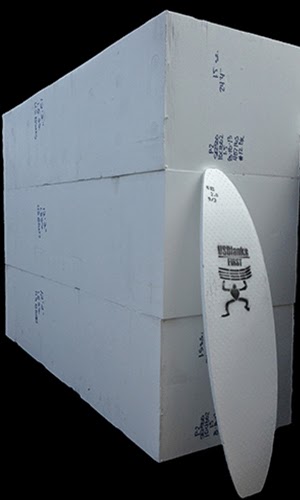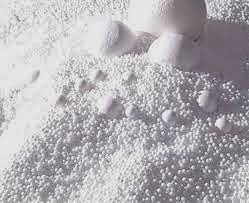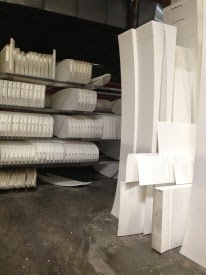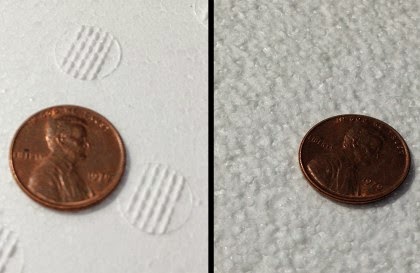 Apr
29
Apr
29
EPS FOAM: Superfused (molded) VS Block Cut (Slab)
- April 29, 2014
- 4 Comment(s)
In addition to the traditional polyurethane foam blanks, US Blanks offers 2 two types of EPS foam blanks: SUPERFUSED and BLOCK CUT. This article is designed to help distinguish the differences between the two.
 |
| EPS Billets and Molded Blank |
KEY TERMS:
EPS: EPS is an abbreviation for “Expanded Polystyrene”. Expanded Polystyrene is a type of foam, sometimes referred to as Styrofoam. US Blanks uses EPS to produce surfboard blanks. It is regarded as lighter and more buoyant than traditional polyurethane foam. It cannot be used with polyester resin due to chemical reaction sensitivity. Epoxy resin works ideally with EPS foam.
Epoxy: Epoxy is a plastic-like resin used as an alternative to polyester resin in the construction of a surfboard. It can be used with both EPS and PU (polyurethane) foam blanks. Epoxy is lighter and stronger than traditional polyester resin and emits 50-75% fewer VOCs (volatile organic compounds) than polyester resin.
Polystyrene is one of the world’s most widely used plastics. It’s made into a variety of forms including foams such as expanded polystyrene, also known as EPS. EPS is a closed-cell foam, made up of tiny, hollow, spherical beads. In fact, EPS is made up of 98% air which is the reason behind its lightweight. Common uses for EPS are packing applications (foam peanuts, ice chests) and construction applications (insulation, void filler). EPS is inert and non-toxic, both to the environment and one’s health. Styrene is naturally occurring in many common foods such as fruits, coffee, cinnamon, and beef. Further, EPS is completely recyclable.
 |
| EPS Beads |
EPS used as surfboard blanks began to emerge as a viable option for surfboard shapers in the mid 1990’s. At the time, Clark Foam dominated the market with their wide variety of polyurethane foam blanks which stemmed the growth of EPS. While the epoxy resin used with EPS blanks was both lighter and stronger than traditional polyester resin, the boards were more expensive to build, had problems with yellowing and were difficult to repair.
Those obstacles, however, were overcome and popularity for EPS blanks grew after the closure of Clark Foam in 2005. Quality polyurethane blanks were temporarily difficult to procure so shapers were required to consider alternative materials. Epoxy technology also improved with cleaner formulas, varying densities, and more controlled flex patterns. All of these factors contributed to the increased acceptance and performance quality of EPS blanks.
EPS blank usage is growing, but still accounts for a relatively small percentage of the surfboard blank marketplace. It is currently the preferred foam for Stand Up Paddle boards and Wake Surfboards.
US Blanks offers two types of EPS foam:
EPS foam is made from a fusing together of small, pre-expanded foam beads. The key difference between SUPERFUSED & BLOCK CUT EPS is the fusion process.
 |
| Slab Cuts |
BLOCK CUT (Slab Cut)
For BLOCK CUT, the beads are fused into a large block (3’x4’x24’). The blanks are then custom cut from the block into a specific size, shape and dimension surfboard blank. This process offers extreme versatility in blank size options. Unused EPS foam scraps are 100% recycled.
SUPERFUSED (Molded)
SUPERFUSED blanks are fused into a pre-cast mold of a designated surfboard blank size, i.e., 6’5” or 7’2”, etc rather than the large block for the BLOCK CUT. While this limits versatility to the number of pre-cast molds, it allows for smaller beads to be more tightly fused and thereby produces a finer finished surface. The resulting foam more closely resembles the tight cell structure of traditional polyurethane foam.
Key Points:
BLOCK CUT allows for superior versatility in blank options. SUPERFUSED allows for tighter cell structure and fusion properties.
 |
| Molded (left) Slab Cut (right) |
EPS FOAM RECAP
Key Benefits: The main benefit of EPS is that it is 100% recyclable. Additionally, it is lighter than polyurethane.
Performance and Flexibility: Performance and flexibility are matters of subjectivity and preference. EPS is lighter and more buoyant than PU. Both of those elements can allow the surfer to ride smaller, lesser volume surfboards which may, in turn, help performance and paddling. The flex properties are certainly different than PU. It is the responsibility of the shaper to determine the board dimension and stringer configuration that is best suited for their client’s needs.
Construction: The construction of an EPS surfboard is basically the same as a traditional PU surfboard. The foam core is shaped into the desired dimension and then wrapped with fiberglass cloth soaked in resin. The main difference is that one must use epoxy resin, as opposed to traditional polyester resin that is used with PU foam. Construction costs are slightly higher for EPS than PU boards.

4 comments on “EPS FOAM: Superfused (molded) VS Block Cut (Slab)”
I really hate shaping EPS and the only tools that (for me) shape without gouging are a belt sander and drywall screen. Are there any tips or techniques for handling this material?
In general using tools that are less abrasive than the tools you would use on a regular poly blank are the best option when it comes to shaping EPS foam. This includes Microplane blades on your surforms and other tools (such as this https://www.foamez.com/microblade-55-p-174.html and this https://www.foamez.com/microplane-large-8-snapin-set-p-1047.html) and working at a slower, steadier rate will help not to gouge the foam as much. These tools and techniques, in our experience, work the best with the soft and tender nature of EPS foam. Of course spackling you blank after shaping and before glassing will help hide any remaining blemishes from shaping as well.
I have no words to explain my feelings about your post
EPS CUTTING
Thanks for this very useful info you have provided us. I will bookmark this for future reference and refer it to my friends. More power to your blog.
EPS CUTTING
Comments are closed.